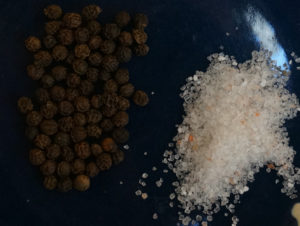Notes toward a Finger Lakes Cuisine: Beyond sustenance with succotash
by Stephen Lewendowski –
A regional cuisine for the Finger Lakes is necessarily grounded in this deep agricultural and ethnobotanical history and summarized in one Native American word: succotash. Like many words scattered over our landscape, succotash originated to the east (the Narragansett coined the word misisckquatash for an ear of corn) and migrated west where it came to be applied to any dish that contained both cooked corn and beans. The Iroquois, as the Ongweh Howeh were called by their neighbors, had many variations on this dish but called succotash ogosase.
A Seneca recipe gathered by Phyllis Williams Bardeau in Iroquois Woodland Favorites (2005) requires “6 ears green corn, 1 pint shelled beans, ¼ cup diced fried salt pork, and salt/pepper. Cut kernels from cobs and scrape off the milk. Place corn in a pot, add the shelled beans, diced salt pork and seasonings. Add water to almost cover (ewowe’sah). Stir frequently (da’ja’ne’) to keep from scorching. Cook for about ½ hour.” To make succotash more authentic, replace the pork with venison, beaver or bear. Archaeologist Arthur Parker’s Iroquois Uses of Maize (1910) specified that both sweet corn and Tuscarora-variety corn in the “green corn” stage were used, and Tuscarora Dorothy Crouse contributed a very similar recipe to Iroquois Indian Recipes (1978). Ethnologist F.W. Waugh’s Iroquois Foods and Food Preparation (1916) adds several details to the process: the corn was pounded to express its “milk” before boiling, half of a deer’s jawbone was the traditional corn-scraping tool, and maple syrup might be added for flavor.
Succotash can be wonderful or awful. It is not a dish that cans well, but it has been canned, overcooked and piled on a plate of meat and potatoes in a way that is not appetizing. Usually, the canned beans are lima beans, a more southern bean than those raised in the Finger Lakes. But who would judge a food by its canned version? Remember that canning’s short history dates from Napoleon’s desire to feed a huge army a long way from home in inhospitable climes.
We are not an occupying army. We are close to home, our earth is not scorched, and at certain times of year when both the corn and beans are ripe, real succotash becomes a possibility here. The absolute necessity for fresh ingredients means that real succotash can only occur for a few months of the year, between mid-July and early October. Break open the pods, shell the immature beans into a sauce pan and cook lightly in water enough to cover. Lima beans are okay, but almost any bean picked short of maturity can be a shell-bean. Shell-beans are partly mature beans in which the pod has not begun to harden and the beans have not developed their final, hard coat. Some Iroquois recipes call for “cranberry-style” beans, big fat round ones. Take a sharp knife (or deer jawbone) and score the corn kernels along their rows. Then hold the ear against a plate and scrape off the corn kernels. Go as deep as you can on the cob (to get the ‘milk’, as Bardeau calls it) and put the kernels into the sauce pan with the half-cooked beans. Some prefer younger corn for greater sweetness, but others like the texture of fully mature kernels. All the authors specify “green corn” for succotash, an important cultural distinction to the Iroquois who celebrate the appearance of that stage of corn development in late July or early August. In our time, sweet corn is corn that is genetically delayed in the “green corn” stage of development, staying sweeter longer. Add some butter (unavailable to the Iroquois) and sauté briefly. Serve and eat with a dish and spoon, or eat it right out of the pan with the serving spoon. You may want to drain off a little of the liquid and replace it with cream (the Iroquois had none) and re-heat.
Voila–the basis of a Finger Lakes regional cuisine.
Admittedly, succotash still sounds like a side-dish, even with the addition of butter and cream. To make it more like a meal, add some dried or freshly fried summer squash to sweeten the mix, as the Jesuits noted in their Relations from the early 1600s. Yellow crookneck and pattypan would be the most authentic squash varieties to use.
If you want more substance yet, consider frying and adding a few bits of fat meat as a garnish to the dish. Presuming that you have neither the fattier parts of bear, beaver nor deer available, a little fried-up or boiled salt pork a.k.a. side-meat or bacon would suit your purposes.
Salt and pepper would taste good on succotash, but neither would have been used in the old days. Remember that all those exploratory voyages were about discovering a new route to the spice isles to bring back peppercorns. The Iroquois got a peppery taste from adding smartweed leaves or black mustard seeds to the dish.
 Salt was known in the New World but not trusted. The Onondaga regarded the salt springs in their territory (currently the City of Syracuse) as unhealthy, perhaps spirit-possessed. Instead of gathering salt from those springs, the Iroquois dried and burned coltsfoot leaves and used the salty ashes as a seasoning. To the detriment of their health, colonial settlers ignored the Indians’ warnings about the overuse of both salt and tobacco.
Salt was known in the New World but not trusted. The Onondaga regarded the salt springs in their territory (currently the City of Syracuse) as unhealthy, perhaps spirit-possessed. Instead of gathering salt from those springs, the Iroquois dried and burned coltsfoot leaves and used the salty ashes as a seasoning. To the detriment of their health, colonial settlers ignored the Indians’ warnings about the overuse of both salt and tobacco.
F. W. Waugh notes that most of the true Iroquois dishes were either some form of bread (baked or boiled) or stew (like succotash) and could have been seasoned with a “handful of gnats.” Anyone trying a first bowl of traditional Iroquois corn soup (whose ingredients are exactly the same as succotash but treated and cooked differently) would find it bland, but they are more likely to reach for the proffered salt and pepper, or sugar, than get themselves a handful of gnats (as Waugh says), a slug of maple syrup, or coltsfoot ashes. Convenience and authenticity are often at odds, but perhaps the coltsfoot and the maple are worth a taste.

Succotash is a promising beginning, but remember that its season is less than a couple months. For the rest of year, a Finger Lakes cuisine would need to rely on stored foods, root crops, animal flesh (migrating birds, salmon runs), seeds, nuts and greens. Each of five or ten major seasons would have its dominant flavor, though some form of corn would appear in each. Arthur Parker says early travelers among the Iroquois were “impressed with the number of ways of preparing corn and enumerate from 20 to 40 methods.”
Editor’s note: Owl Light News will feature more “Notes toward a Finger Lakes Cuisine”in upcoming Owl issues.
 Stephen Lewandowski was born in Canandaigua, NY in 1947. When his ethnobotanist parents were killed in a plane crash, he survived and was reared by bears in the Southern Tier of New York. Later, he was discovered, shaved and clothed, and sent to Hamilton College where he studied English Literature. Not completely civilized by this experience, he also did graduate work in philosophy and folklore. He enjoys being outdoors and, being recently retired from gainful employment with the Soil Conservation, hopes to range freely again. Writing, even thinking, is painful to him.
Stephen Lewandowski was born in Canandaigua, NY in 1947. When his ethnobotanist parents were killed in a plane crash, he survived and was reared by bears in the Southern Tier of New York. Later, he was discovered, shaved and clothed, and sent to Hamilton College where he studied English Literature. Not completely civilized by this experience, he also did graduate work in philosophy and folklore. He enjoys being outdoors and, being recently retired from gainful employment with the Soil Conservation, hopes to range freely again. Writing, even thinking, is painful to him.